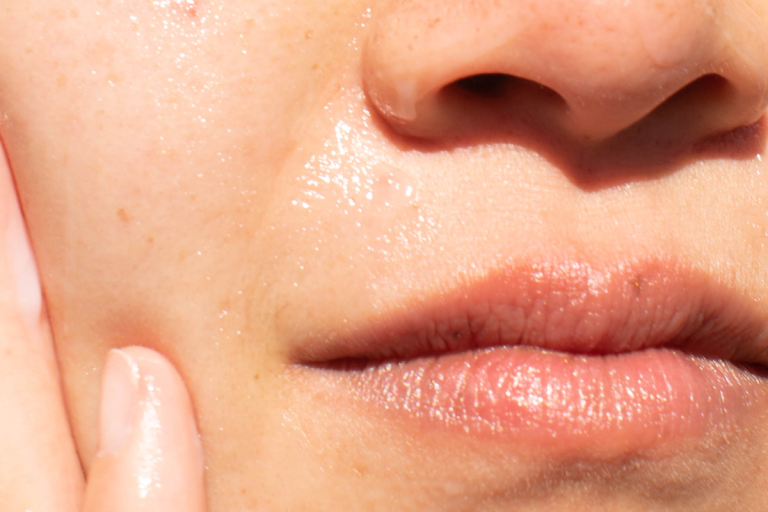How it works:
Share your skin goals and snap selfies
Your dermatology provider prescribes your formula
Apply nightly for happy, healthy skin
How it works:
How it works:
Share your skin goals and snap selfies
Your dermatology provider prescribes your formula
Apply nightly for happy, healthy skin
How it works:
How tranexamic acid can help prevent hyperpigmentation
Tranexamic acid is a game-changer in skincare, helping to prevent hyperpigmentation and reduce inflammation.



In this article
Blotchy or spotted skin are common skin concerns, but let’s face it—brown spots and red spots are no fun to deal with. Post-inflammatory hyperpigmentation, melasma, and rosacea are three of the most common culprits for leaving your skin tone looking uneven, blotchy, and spotted. Fortunately, there are several great skincare ingredients that can help reduce the appearance of discolored skin, like tranexamic acid.
Oral tranexamic acid (or TXA) is sometimes used as a short-term treatment for heavy menstrual bleeding, but topical application to help treat blotchy or spotted skin is becoming increasingly more common. When applied to the skin, it inhibits the production of melanin,¹ the pigment that gives skin its color. Curology uses a variety of ingredients specifically equipped to tackle dark spots, and tranexamic acid is one of them.
What causes skin spots?
Before we dive into tranexamic acid, let’s review a few causes of skin spots. Dark spots or discoloration can happen for several reasons. Uneven skin tone can result from too much ultraviolet sun exposure, resulting in sun spots or from inflammatory conditions (such as acne) or certain immune disorders. Treatment recommendations may differ based on the cause of your pigmentation, and it’s important to consult a dermatology provider if you notice anything that leaves you wondering.
Common causes of skin discoloration that may benefit from the use of tranexamic acid include:
Post-inflammatory hyperpigmentation (aka post-acne spots):² Often incorrectly referred to as acne scars, brown spots that remain once acne has cleared are different from true scarring (and therefore treated differently).
Melasma: A common skin condition that causes symmetrical brown patches to appear, melasma is most frequently seen on the sun-exposed areas of the face and neck. Roughly 90% of people who experience melasma are women.³
Rosacea:⁴ This condition can present in a variety of ways including persistent facial redness or small, pus-filled bumps. The skin may feel dry or sensitive as a result of a diminished skin barrier. It’s a chronic immune-mediated inflammatory skin disease that can cause frequent blushing and flushing.⁵

What is tranexamic acid?
Tranexamic acid comes from the amino acid lysine and belongs to a class of medications known as antifibrinolytics.⁶ When taken orally, tranexamic acid can decrease blood loss by helping the body form blood clots. Currently, oral tranexamic acid is FDA-approved for the treatment of women with heavy menstrual bleeding and for short-term prevention of blood loss in hemophiliacs.⁷
Relatively new to skincare, tranexamic acid has been shown to strengthen the skin’s barrier when applied topically.⁸ In addition, tranexamic acid has anti-inflammatory properties and can help treat conditions like melasma, post-inflammatory hyperpigmentation, and rosacea.
How does tranexamic acid work?
A common cause of hyperpigmentation is a buildup of excess melanin (the substance that gives skin its color). Excess melanin can occur as a result of inflammatory conditions like acne (post-inflammatory hyperpigmentation), sun exposure (sun spots or age spots), or hormonal changes, as is often the case with melasma.
Tranexamic acid can inhibit melanin production, which decreases the appearance of hyperpigmentation in the skin.⁹ One study found that nearly 80% of patients who applied topical tranexamic acid daily noticed an improvement in their skin tone in as little as two weeks.¹⁰ In another study, researchers found tranexamic acid to be effective when used to treat inflammatory acne.¹¹ That study also noted its ability to decrease redness in patients with inflammatory acne.

How can I get tranexamic acid?
Tranexamic acid is available without a prescription in some brand-name over-the-counter products, but it’s not necessarily the best choice for everyone. If it’s right for your skin, your Curology dermatology provider may include it as part of your Custom Formula. That way, you know you’re getting exactly what you need for your unique skin type and the conditions you’re experiencing. For example, your formula might include tretinoin for acne and TXA for hyperpigmentation. Whatever the combination, it’s completely customized for you. And if you have questions or concerns, your dermatology provider is there with you every step of the way!
How long does it take to see results?
Like with any new skin care treatment, results can take a little time and may vary from person to person. You may need to use tranexamic acid for six to eight weeks or longer before noticing any changes (although this can differ—everyone’s skin is different!). Remember, skincare is a journey, and a little patience goes a long way.
Who can use tranexamic acid?
So far, research shows people with rosacea or dark spots from melasma or post-inflammatory hyperpigmentation may benefit from the effects of tranexamic acid. Here’s a breakdown of the research:
In a study conducted in 2015,¹² topical application of 3% tranexamic acid improved visible signs of rosacea. The authors linked the mechanism of action to improved skin barrier function.
A 2019 study explored the efficacy of two treatments for melasma: tranexamic acid verses hydroquinone. After 12 weeks, patients who used TXA experienced noticeable signs of melasma reduced by 27%.¹³
In 2021, a study evaluated the effectiveness of a tranexamic acid derivative on sun-damaged skin.¹⁴ Results demonstrated improved skin tone as well as reduced facial redness and dark spots.
A 2022 study evaluated the efficacy of tranexamic acid on post-inflammatory erythema. It showed that topical use of tranexamic acid improved the appearance of these areas.¹⁵
We’re talking about using tranexamic acid as a topical skin care treatment, not an oral medication. And if you’re pregnant or breastfeeding, let your medical provider know, as they may provide you with additional recommendations.
What should I consider before using tranexamic acid?
The most common potential side effects of topical tranexamic acid are mild—mostly dryness, flaking, and irritation. Dry and flaky skin can be treated with a moisturizer after applying a tranexamic acid treatment. Mild irritation or increased redness may occur after using a product that contains tranexamic acid, so check out these helpful tips to help ease these symptoms if they occur. While serious side effects are not common, if you experience significant irritation, stop using the product right away and get in touch with your medical provider for more hands-on help or visit an in-person dermatology provider.

Try Curology's custom skincare for dark spots
If you need help fading hyperpigmentation or reducing redness, Curology’s personalized prescription formulas are a convenient way to get effective ingredients to help fade dark spots.
Get your personalized skincare routine with Curology
Get your personalized skincare routine with Curology


With Curology, you’re paired with a licensed dermatology provider to create a personalized skincare routine designed for your specific skin concerns. Just take a quick skin quiz and snap a few selfies, and one of our medical providers will evaluate your skin. If Curology is right for you, we’ll send you a free 30-day supply of your custom formula—just pay $5.45 (plus tax) to cover shipping and handling. Get your personalized skincare routine with Curology now!
FAQs
Common causes of skin discoloration that may benefit from the use of tranexamic acid include Post-inflammatory hyperpigmentation (acne scars), Melasma which causes symmetrical brown patches, and Rosacea (facial redness or small bumps).
Tranexamic acid comes from the amino acid lysine and belongs to a class of medications known as antifibrinolytics. When taken orally, tranexamic acid can decrease blood loss by helping the body form blood clots.
It can inhibit melanin production, which decreases the appearance of hyperpigmentation in the skin.
Tranexamic acid is available without a prescription in some brand-name over-the-counter products, but it’s not necessarily the best choice for everyone.
Like with any new skincare treatment, results can take a little time and may vary from person to person. You may need to use tranexamic acid for six to eight weeks or longer before noticing any changes.
Research shows people with rosacea or dark spots from melasma or post-inflammatory hyperpigmentation may benefit from the effects of tranexamic acid.
P.S. We did the homework so you don’t have to:
Desai, S., et al. Effect of a Tranexamic Acid, Kojic Acid, and Niacinamide Containing Serum on Facial Dyschromia: A Clinical Evaluation. Journal of Drugs in Dermatology. (2019, May).
Ko, D., et al. Disorders of Hyperpigmentation. Part II. Review of management and treatment options for hyperpigmentation. Journal of the American Academy of Dermatology. (2022).
Ebrahimi, B., et al. Topical Tranexamic Acid as a Promising Treatment for Melasma. Journal of Research in Medical Sciences. (August 2014).
Bageorgou, F., et al. The new therapeutic choice of tranexamic acid solution in treatment of erythematotelangiectatic rosacea. Journal of cosmetic dermatology. (2019).
Medgyesi, B., et al. Rosacea is Characteized by a Profoundly Diminished Skin Barrier. Journal of Investigative Dermatology. (2020, October).
Silva, E.M.P., et al. Analytic Methods for Quantification of Tranexamic Acid in Biological Fluids: A Review.Microchemical Journal. (September 2017).
Chauncey, J. M., & Wieters, J. S. Tranexamic Acid. In StatPearls. StatPearls Publishing. (2022).
Zhong, S., et al. Topical Tranexamic Acid Improves the Permeability Barrier in Rosacea. Dermatologica Sinica. (2015, June).
Kim, H.J., et al. Efficacy and Safety of Tranexamic Acid in Melasma: A Meta-analysis and Systematic Review. Acta Dermato-Venereologica. (2017, April).
Souza, I.D.S., et al., New Topical Tranexamic Acid Derivative for the Improvement of Hyperpigmentation and Inflammation in the Sun-damaged Skin. Journal of Cosmetic Dermatology. (2021, February).
Charoenwattanayothin, A., et al. Adjunctive Treatment for Acne Vulgaris by Tranexamic Acid. Journal of Cosmetic Dermatology. (2022, April 7).
Zhong, S., et al. Topical Tranexamic Acid Improves the Permeability Barrier in Rosacea. Ibid.
Janney, M.S., et al. A Randomized Controlled Study Comparing the Efficacy of Topical 5% Tranexamic Acid Solution Versus 3% Hydroquinone Cream in Melasma.Journal of Cutaneous and Aesthetic Surgery. (2019, January-March).
Souza, I.D.S., et al., New Topical Tranexamic Acid Derivative for the Improvement of Hyperpigmentation and Inflammation in the Sun-damaged Skin. Journal of Cosmetic Dermatology. (2021, February).
Kalantari, Y. et al., Post-acne Erythema Treatment: A Systematic Review of the Literature. Journal of Cosmetic Dermatology. (2022, April).
This article was originally published on October 22, 2020, and updated on July 21, 2022.
*Cancel anytime. Subject to consultation. Subscription is required. Trial is 30 days + $4.95 shipping and handling.

Curology Team

Nicole Hangsterfer, PA-C
Related Articles
25 skincare myths debunked: what you need to knowAsk a skin expert: Your skin’s damaged skin barrierWhat’s causing your skin irritation and how to stop itForehead acne: what’s up with that?How to treat dry, flaky skin and rosaceaPopular Articles
Ask Curology: Is my cold breaking me out?Slugging: The dermatologist-approved skincare hack going viral on TikTokTretinoin vs retinol: What’s the difference?How to create a self-care routine that actually sticksYour 2023 skincare horoscopeTry prescription skincare
Get routine essentials


Good skin days ahead
Good skin days ahead
- Breakouts
- Redness
- Fine lines
- Dark spots
- Hair thinning
$29.95/month